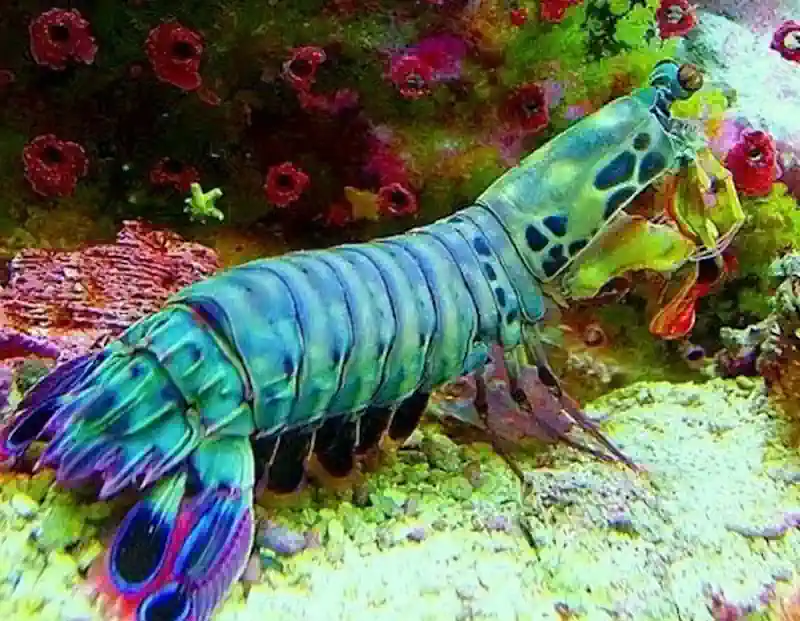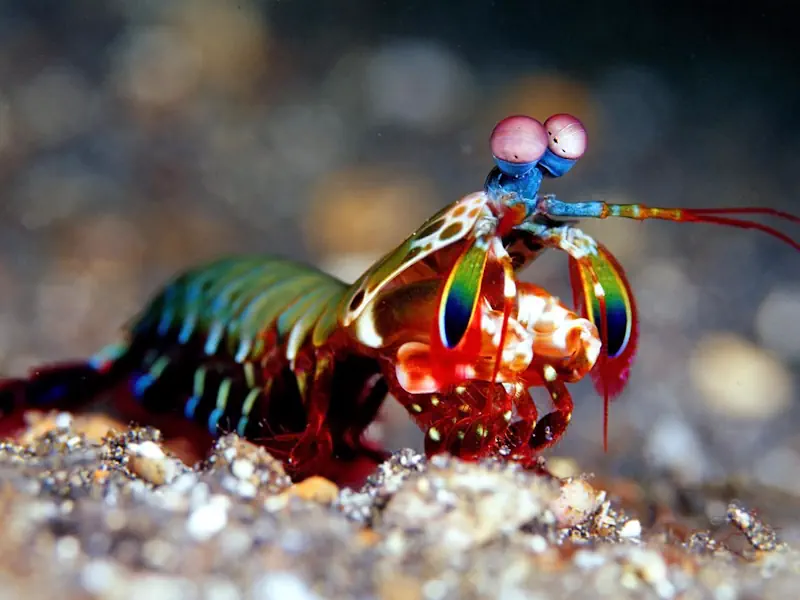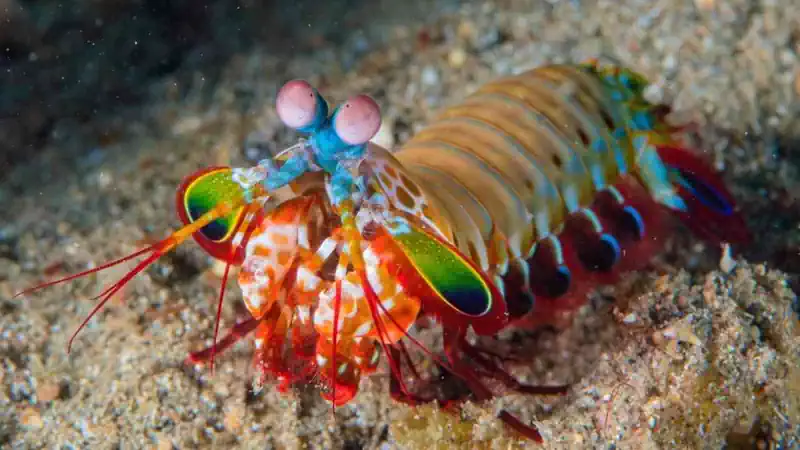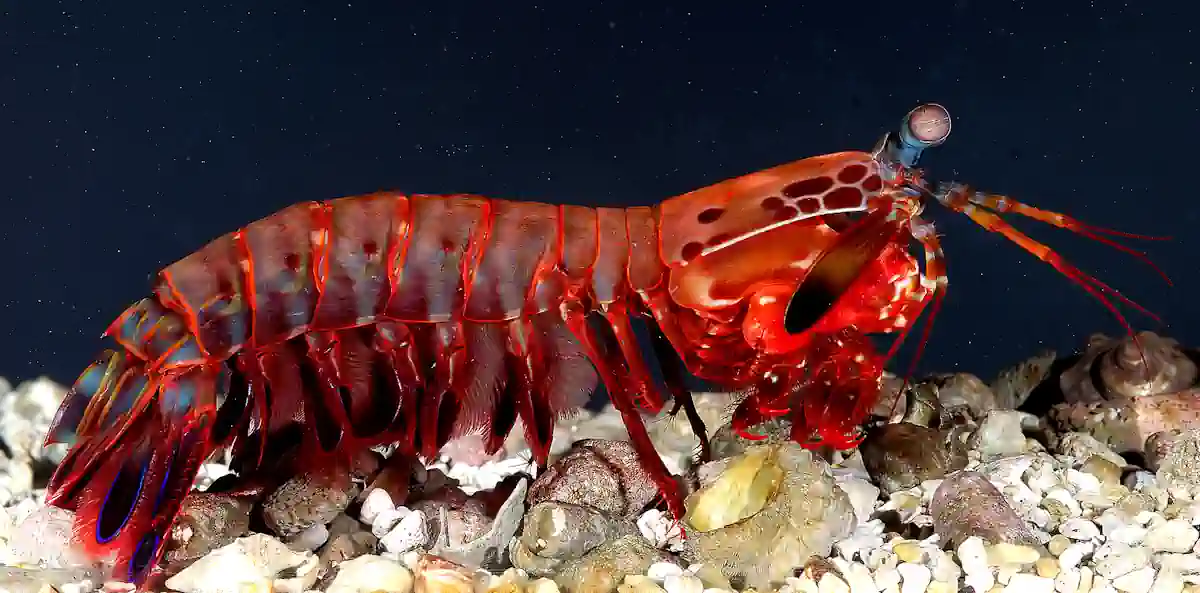Fish Yefdw – The mantis shrimp, a fascinating and fearsome creature of the sea, packs a powerful punch that belies its small size. Don’t let the name fool you – these colorful crustaceans are neither true shrimp nor praying mantises, but a unique species unto themselves. With their striking appearance and incredible abilities, mantis shrimp have captured the attention of scientists and ocean enthusiasts alike.
Mantis shrimp belong to the order Stomatopoda and are distant relatives of crabs, lobsters, and shrimp. Over 400 different species of mantis shrimp inhabit tropical and subtropical waters around the globe, with a particularly high concentration in the Indo-Pacific region. These intriguing invertebrates come in a dazzling array of colors, from vibrant reds and greens to more muted tones that allow them to blend in with their surroundings.
One of the most remarkable features of the mantis shrimp is its specialized forelimbs, which have evolved into formidable weapons. Depending on the species, these appendages take the form of either spear-like structures used for harpooning soft-bodied prey or club-like hammers capable of delivering devastating blows to hard-shelled creatures like crabs and clams. The speed and strength of the mantis shrimp’s strike is unparalleled in the animal kingdom.
What Are Mantis Shrimp?

Despite their name, mantis shrimp are not actually shrimp at all. These fascinating sea creatures are a type of stomatopod, distant cousins of crabs and lobsters that have existed for over 400 million years. There are more than 450 unique species of mantis shrimp found in tropical and subtropical waters around the world, especially in the Indian and Pacific Oceans.
Mantis shrimp get their name from their powerful, raptorial claws that resemble those of the praying mantis insect. Depending on the species, mantis shrimp are categorized as either “spearers” or “smashers” based on the type of claws they brandish to hunt prey and defend themselves.
The Anatomy of a Mantis Shrimp
The average mantis shrimp measures around 10 cm (4 inches) in length, but some species can reach up to 38 cm (15 inches) long. Their bodies are flattened and segmented, often sporting vivid colors and intricate patterns in shades of green, red, orange and blue.
Incredible Eyes

One of the mantis shrimp’s most remarkable features is its sophisticated eyes. Perched on mobile stalks, their eyes move independently of each other and have the most complex vision of any animal we know of. While humans have three types of color receptors, mantis shrimp have between 12-16 different photoreceptors, allowing them to see ultraviolet, visible and polarized light.
However, recent research suggests mantis shrimp vision is not as advanced as once believed. Despite their multitude of photoreceptors, studies show mantis shrimp are actually not very good at distinguishing between colors compared to other animals. Scientists now think their unique eye structure may be more tuned for detecting light patterns rather than discerning color nuances.
Powerful Weaponry
The mantis shrimp’s claim to fame is its lethal striking power. Equipped with either sharp spear-like appendages or club-shaped “fists,” mantis shrimp deliver one of the fastest and most powerful punches in nature.
“Smasher” species like the peacock mantis shrimp have calcified clubs that accelerate with the same velocity as a gunshot from a .22 caliber rifle. Traveling at 23 meters per second, their strikes create a force of 1,500 newtons – enough to shatter aquarium glass and split human thumbs, earning mantis shrimp the nickname “thumb splitters.”
The speed of these strikes also creates cavitation bubbles between the shrimp’s fist and its prey. When these bubbles collapse, they release an intense shockwave that can stun and kill the target in addition to the initial punch. Remarkably, the mantis shrimp’s club is structured in a way to protect it from self-inflicted damage.
Habitat and Behavior
Mantis shrimp inhabit the seafloor of tropical and subtropical waters, constructing burrows in coral rubble or sediment. Spearers typically build sandy burrows, while smashers prefer rocky crevices. These solitary creatures are highly territorial and will aggressively defend their homes.
While some species of mantis shrimp form monogamous pairs that share a burrow for life, most live alone and only come together to mate. After breeding, females lay clusters of eggs that they carry under their tails until tiny mantis shrimp hatch a few months later.
Mantis shrimp are ambush predators, waiting at the entrance of their burrows to snatch passing prey with lightning speed. Spearers tend to hunt soft-bodied prey like fish and squid, while smashers prefer hard-shelled meals like clams, snails and crabs. Some large mantis shrimp will even eat other mantis shrimp.
Surprising Intelligence

Don’t let their brutish claws fool you – mantis shrimp are remarkably intelligent for an invertebrate. They exhibit complex social behaviors, engage in ritualized fighting, and can learn to recognize other individual mantis shrimp.
Studies have shown that mantis shrimp can remember the location of a food source and navigate back to it later, demonstrating an impressive spatial memory. They are one of the few invertebrates that use tools, manipulating rocks and shells to hide and protect their soft bodies.
Mantis Shrimp and Humans
While mantis shrimp are highly aggressive, they pose little threat to humans unless handled. Some fishermen consider them pests for stealing bait and damaging nets, but many mantis shrimp species are a popular delicacy in Asian cuisine.
In the marine aquarium trade, mantis shrimp are prized for their vibrant colors and interesting behaviors. However, they often hitchhike into tanks as larvae hidden in coral or rock and can wreak havoc on other tank inhabitants with their predatory nature. Many aquarists consider them unwanted pests.
The powerful punch of the mantis shrimp is inspiring research into tougher materials and advanced body armor designs. By studying the shock-absorbing structures in the mantis shrimp’s club, scientists hope to develop better impact-resistant synthetic materials.
Threats and Conservation
Currently, the mantis shrimp is not considered a threatened species. While they are sometimes harvested for food, the impact of fishing on their populations is not well understood. Like other coral reef species, mantis shrimp face habitat loss from coastal development, pollution, and climate change.
As both predator and prey, mantis shrimp play an important role in their coral reef ecosystems by controlling populations of their prey species and serving as food for larger predators. Some scientists consider them a keystone species, meaning their influence on their habitat is disproportionately large for their size.
Fascinating Mantis Shrimp Facts
- The mantis shrimp packs a punch that accelerates faster than a .22-caliber bullet.
- Mantis shrimp are older than dinosaurs, having diverged from other crustaceans over 400 million years ago.
- The eyes of mantis shrimp are considered the most complex in the animal kingdom with 12-16 photoreceptors.
- Some mantis shrimp species can break through aquarium glass and fisherman’s thumbs, giving them the nickname “thumb splitters.”
- Mantis shrimp are highly intelligent, able to use tools, learn from experience, and recognize individuals.
- Mantis shrimp can see ultraviolet and polarized light invisible to the human eye.
- The striking appendage of the mantis shrimp can reach speeds of 23 meters per second, making it one of the fastest limb movements in the animal kingdom.
- The shock wave created by the mantis shrimp’s punch generates light, heat and sounds, a phenomenon called sonoluminescence.
Appreciating the Marvelous Mantis Shrimp
So the next time you spot a mantis shrimp while snorkeling or diving, take a moment to appreciate the fascinating natural history and amazing abilities of these pint-sized powerhouses.
From their stunning coloration to their mighty claws, mantis shrimp are one of evolution’s most spectacular creations. Just be sure to keep your fingers clear of the “thumb splitters”!






Leave a Comment